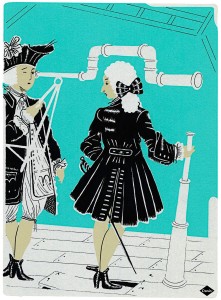
“During the Enlightenment, every fixed point of knowledge began to wobble.” Illustration for The New Yorker by Brian Cronin.
Down in New York, reviewing the new book The Dream of Enlightenment by Anthony Gottlieb, critic and poet Adam Kirsch has penned a longand wide-ranging essay that considers our modern moment. Are we really as alienated from history in the year 2016, and as disrupted by technology from our cultural forebears, as it is sometimes fashion to profess? Kirsch thinks not; “Modernity cannot be identified with any particular technological or social breakthrough. Rather, it is a subjective condition, a feeling or an intuition that we are in some profound sense different from the people who lived before us.” He writes:
If we are looking for the real origins of the modern world, then, we have to look for the moment when that world was literally disoriented–stripped of its sense of direction. Heliocentrism, the doctrine that the earth revolves around the sun rather than vice versa, was announced by Copernicus in 1543 and championed by Galileo in the early sixteen-hundreds. This revelation was immediately experienced as a profound dislocation, as John Donne testified in his 1611 poem An Anatomy of the World: The sun is lost, and the earth, and no mans wit / Can well direct him where to look for it. More than two hundred and fifty years later, Nietzsche was reeling from the same cosmic loss of direction: What were we doing when we unchained this earth from its sun? . . . Are we not plunging continually? Backward, sideward, forward, in all directions? Is there still any up or down? Modernity is a vertigo that began in the sixteenth century and shows no sign of letting up.
(Emphasis added.)
Over the course of his review, Kirsch manages to reference Donne, Copernicus, Leibniz, Nietzsche, Newton, Spinoza, Hume, and a dozen and more other major thinkers, spelling out the marquee authors of a syllabus that is more of less Core-like in nature. How cheering to think that these authors, so long ago alive and active, remain relevant even now, centuries from their time… but then, that’s the Core concept, isn’t it? These are the books of the ever-present tradition.
Read his full essay online at The New Yorker.
